ROBERT WILLIAMS BUCHANAN (1841 - 1901)
|
ROBERT WILLIAMS BUCHANAN (1841 - 1901) |
|
|
|
|
|
|
|
|
A ROBERT BUCHANAN FILMOGRAPHY - continued (ii)
A MAN’S SHADOW (1920)
The Stage (26 August, 1920 - p.15) A Shoreham Man’s Shadow. I met Langhorne Burton, who tells me he has been to Sussex for the taking of three new films at the Morgan Studios, Shoreham-on-Sea, and is about to return to start a fourth. The one just finished is a picturisation of the once celebrated Haymarket success “A Man’s Shadow,” in which he performs the dual rôle made famous in the past by the late Sir Herbert Tree. His next will be lead in Besant’s “Children of Gibeon,” in which Alice de Winton will also take an important character. Dickens’s “Little Dorrit,” with Lady Tree, George Foley, and little Joan Morgan in the cast, taken by the same firm, will shortly be shown at the London Pavilion. As an old Dickensian, I hope to report favourably upon its merits. ___
The Dudley Chronicle (4 December, 1920 - p.8) A Man’s Shadow. “A Man’s Shadow” is a drama of mistaken identity. and Violet Graham, who plays opposite Langhorne Burton in the Butcher’s progress Production must hold the record for being mistaken for some other stage or screen celebrity. Not long ago, when filming at “Mumbles Head,” the Progress Company on returning to their hotel were surprised to find an enormous crowd awaiting their arrival. As soon as Miss Graham got out of the car, a mysterious murmur went through the crowd, “Here she is, here comes Lucy.” No one could guess the meaning of it all, and reaching the hotel safely after some difficulty, it was discovered that the local picture palace was running a “Lucille Love” serial, and Lucille Love had been recognised inn their very midst. Nothing would convince the locals otherwise, and nothing would persuade the crowd to move until Lucille Love appeared on the hotel balcony and made a pretty speech. When she was playing Lily Elsie’s part in “Mavourneen” at His Majesty’s Theatre, in spite of the change of cast being extensively advertised, most of the audiences left the theatre firmly convinced that they had seen Lily Elsie. During the recent production of “A Man’s Shadow,” the Company were at work in Brighton. A ore than usually large crowd assembled at one particular spot, and the producer began to wonder at the excitement. Presently he was taken by the arm by a local reporter who, speaking in a stage whisper said, “Which car is Gladys Cooper in?” “She’s not here with my company,” was the reply. “Don’t bluff me,” said the reporter, “I know you don’t want your work interfered with, but if you won’t tell me on the quiet, I shall have to give it away by searching.” “You will find Violet Graham in the last car but one” was the producer’s information. ___
The Bioscope (9 December, 1920 - p.35) |
 |
|
Daily Mail (11 December, 1920 - p.1 |
|||||
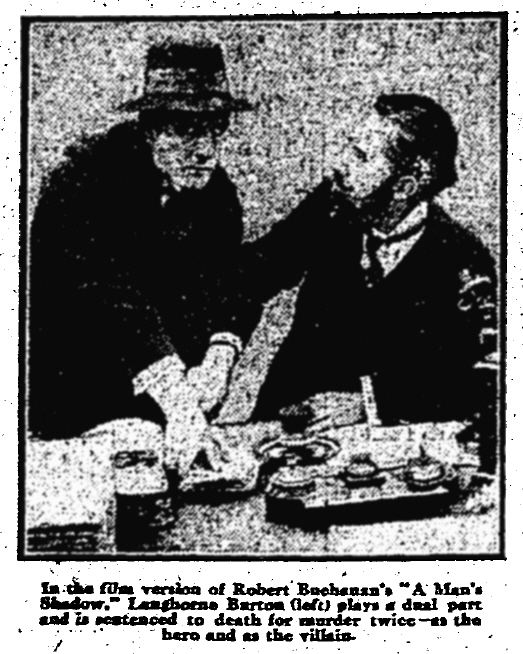 |
|||||
|
The Bioscope (16 December, 1920 - p.73) “A Man’s Shadow” Innocent man suffers through the misdeeds of his unknown Butcher (Progress) 5 reels Featuring: Langhorne Burton, Violet Graham, Gladys Mason, Unknown to himself, Peter Beresford, a young married man in financial difficulties, has a double, Julian Grey, who, aware of their resemblance, impersonates him and murders a moneylender. Beresford is arrested after receiving a forged note containing some of the stolen money, purporting to come from Yolande, wife of his barrister friend, Hampden, but really sent by Grey, who knows of Yolande’s secret acquaintance in the past with Beresford. At the trial Beresford refuses to say whence he obtained the stolen money, but Hampden, who is defending him, receives from Grey a copy of the forged letter, and, believing Yolande unfaithful, dies of shock. Beresford is sentenced to death, but, while he is awaiting execution, Yolande, who alone knows of Grey’s existence, takes up the threads of the case, and tracks the murderer down. Eventually Grey is arrested, and Beresford set free to return to his wife and child. |
|||||
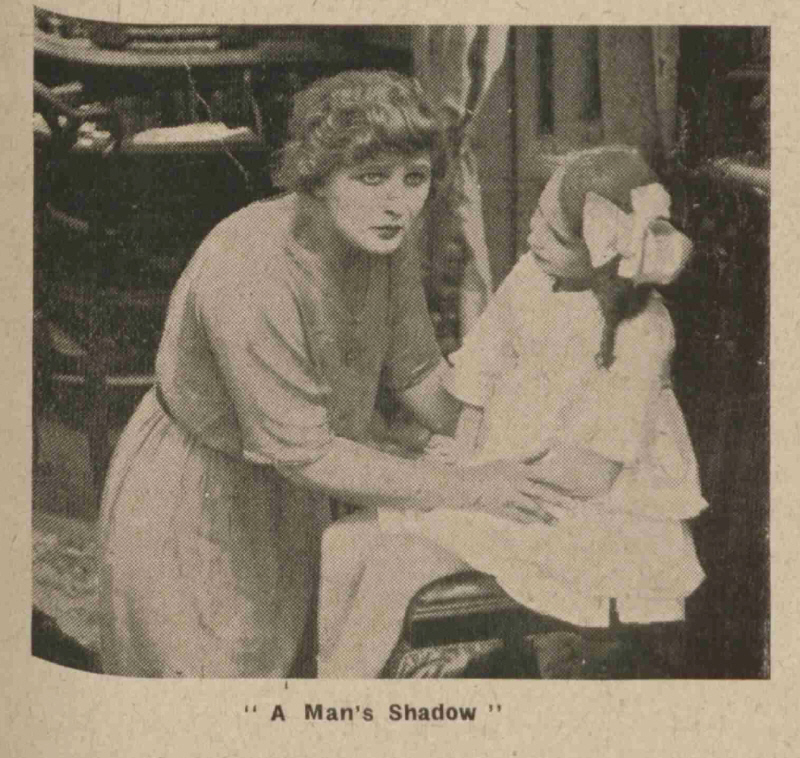 |
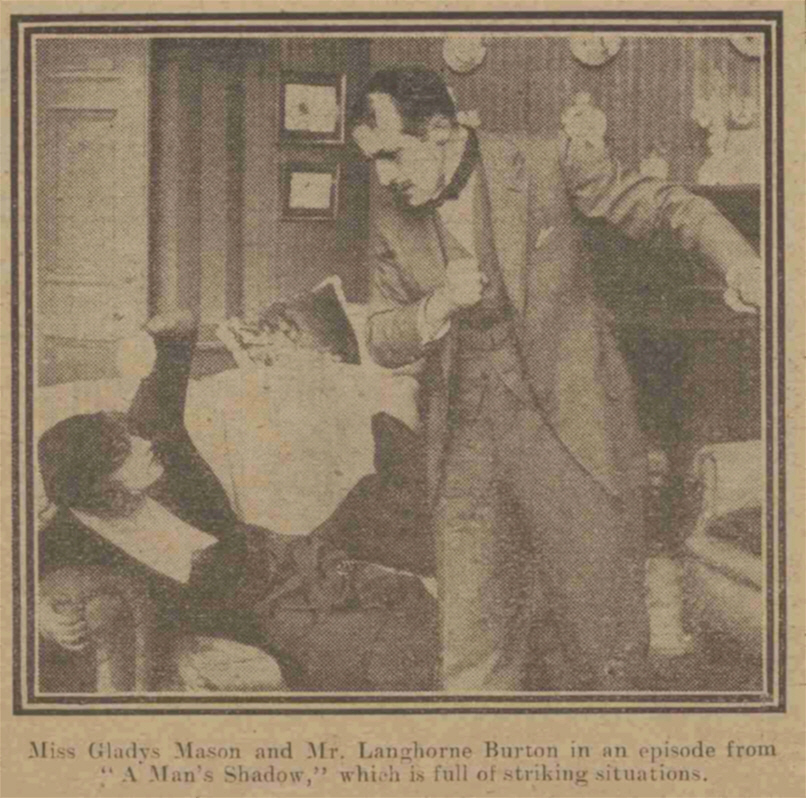 |
|
Western Morning News (7 January, 1922 - p.7) SAVOY PICTURE HOUSE.—Two interesting items in the programme commencing on Monday are “A Man’s Shadow,” featuring Langhorne Burton, and “Love’s Pay Day,” in which Rosemary Thebe takes the leading part. The former is from Sir Herbert Tree’s Haymarket success by Robert Buchanan, while the other is an absorbing story of a young fishing girl who, in consequence of love of gaiety, was the means of the downfall of her lover. On Thursday the chief exhibit will be the All-British film entitled “Nothing Else Matters,” featuring Hugh E. Wright, Moyna Maggill, and Betty Balfour. This is a great human story, interwoven with which is a touching love plot. Next comes “The Sea Wolf,” one of Jack London’s enthralling stories, and an excellent comedy will complete the programme. ___
The Illustrated Leicester Chronicle (7 January, 1922 - p.6) |
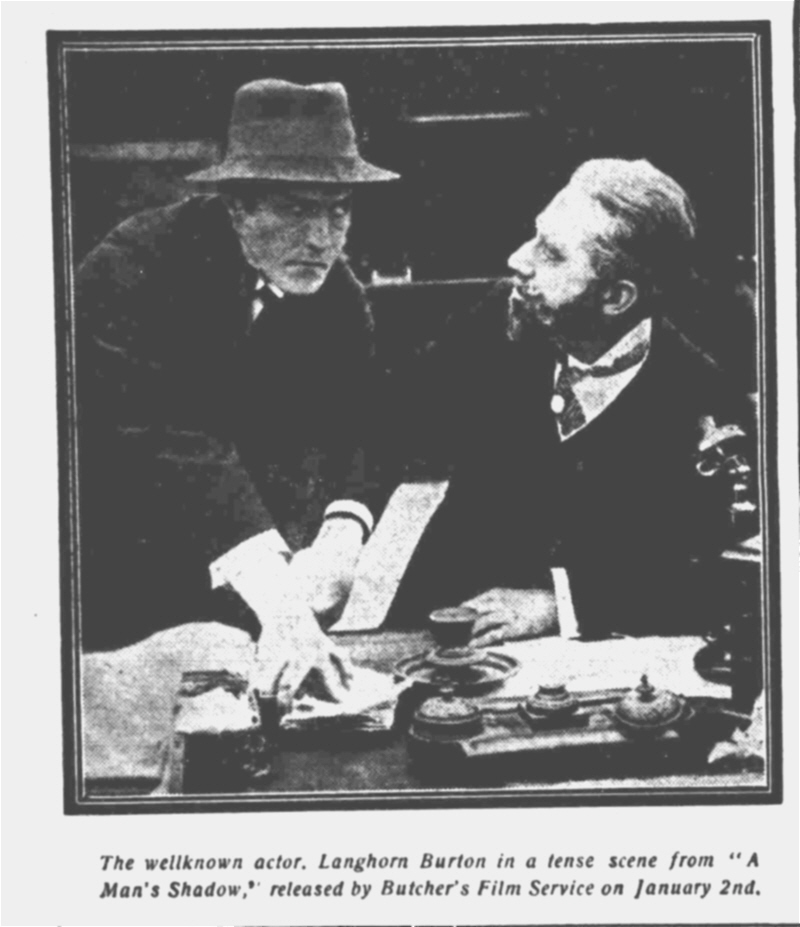 |
|
Grantham Journal (14 January, 1922 - p.7) |
|||||||||||
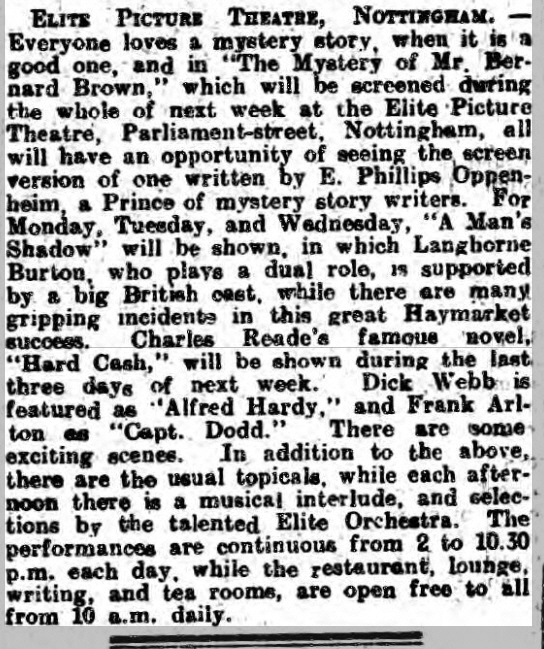 |
|||||||||||
|
The Worthing Herald (21 January, 1922 - p.3) |
|||||||||||
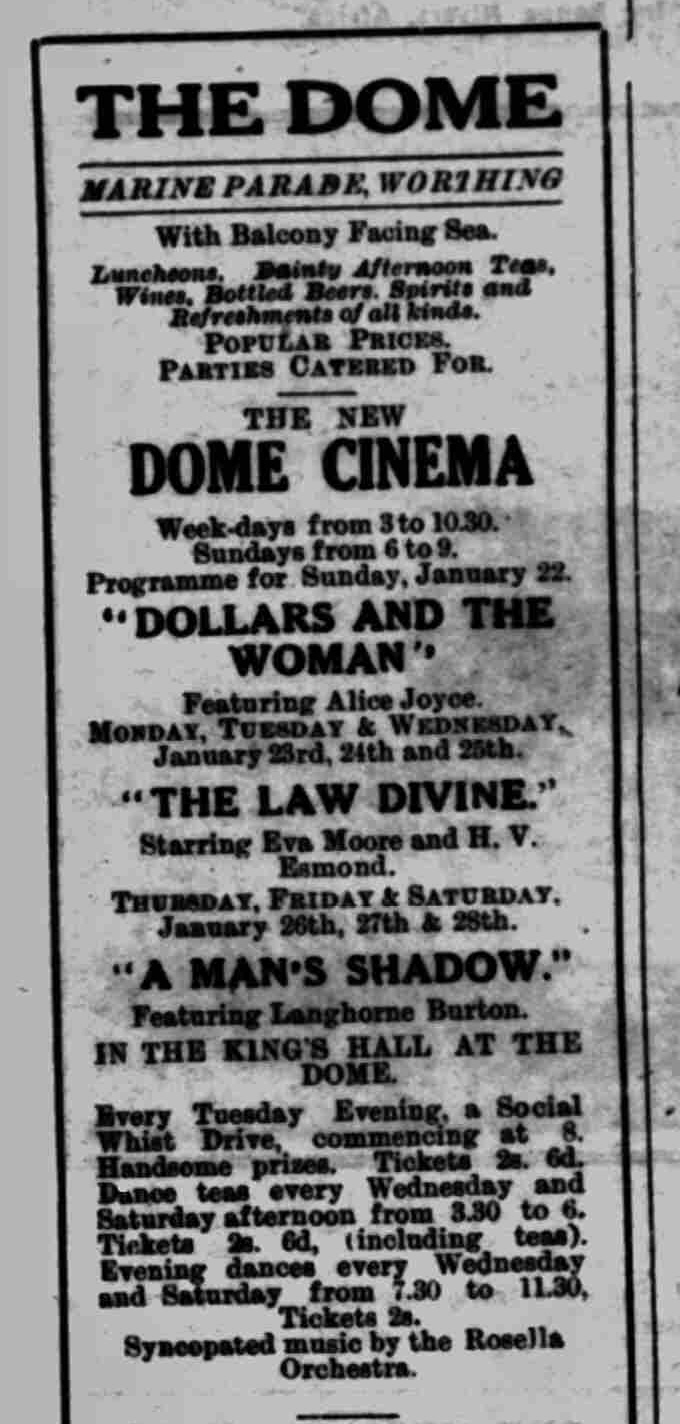 |
|||||||||||
|
[On a personal note: ___
The Burnley News (18 February, 1922 - p.15) LANGHORNE BURTON’S DUAL ROLE. The work of Langhorne Burton is so well known to patrons of the Alhambra that the announcement of his appearance in “A Man’s Shadow” on Thursday, Friday and Saturday next will meet with general approval. Fresh from Butcher’s Service, this film gives Langhorne Burton a great opportunity of displaying his ability in as much as he figures in a dual role. From the beginning to end events move rapidly, and as they are interpreted by a strong cast the picture leaves nothing to be desired. Supporting Langhorne Burton are Violet Graham, Arthur Lennard, Gladys Mason, J. Warris Linden, Babs Ronald, T. Denton Thompson, and Sydney Paxton. ___
Exeter and Plymouth Gazette (17 July, 1922 - p.2) |
|||||||||||
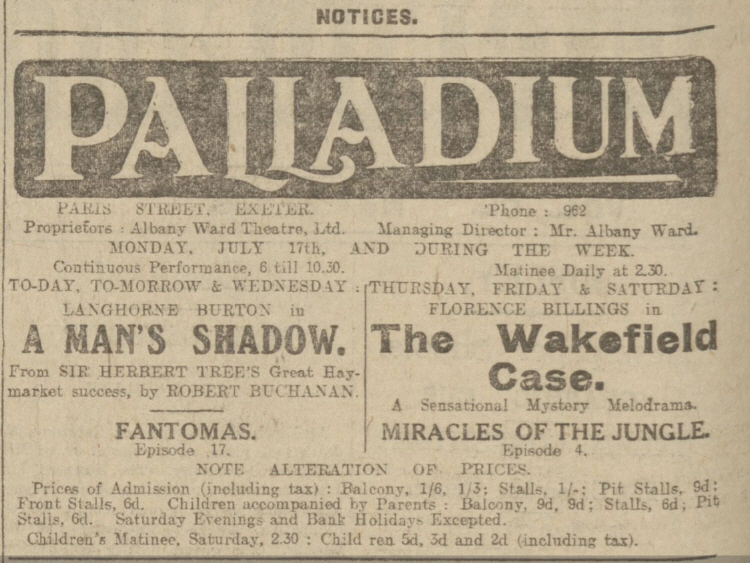 |
|||||||||||
|
_____
THE LIGHTS OF HOME (1920)
The Bioscope (30 September, 1920 - p.54) I hear from John Stuart, who is playing juvenile lead in Screen Plays’ “Lights of Home,” in Cornwall, that the company have met with extremely bad weather during their stay in the West country. The party journeyed from London by road, travelling a distance of 270 miles to Fowey, where many of the exteriors will be taken. ___
The Bioscope (7 October, 1920 - p.63) Cecil Morton York writes me from Fowey, where he is playing in “The Lights of Home,” now being produced by Stirling Films. Mr. York says that this is the first experience of playing in sunlight by artificial light, the producer taking no risks, and carrying a lighting plant which can be used in any interior, or as supplementary to the ordinary daylight. The cottage interiors of this Cornish village will therefore provide authentic settings which will entirely eliminate studio work in this adaptation of a favourite drama. ___
The Bioscope (16 December, 1920 - pp.70-71) “The Lights of Home” Sound and pleasing story of Cornish fisher life— British Exhibitors Films 5 Reels Featuring: George Foley Tress Purvis, the daughter of Dave Purvis, a Cornish fisherman, falls victim to the seduction of Arthur Tredgold, an artist, who deserts her after a promise of marriage. Mark, a young sailor who has grown up with Tress, proposes marriage, and on his refusal goes away to sea. Philip, a friend of Mark, is in love with Sybil, the niece of Garfield, a neighbouring squire, who wishes her to marry Tredgold, a friend of the family. Tredgold inspires Sybil with jealousy against Philip and induces her to break her engagement. Tress hears of the marriage arranged between Tredgold and Sybil and denounces him in her hearing. Dave discovers the truth, and vows to kill Tredgold. There is a struggle between the two on the top of a cliff, over which Tredgold falls and is believed to be killed. He is, however, rescued by the ship on which Mark is returning home, and brought to book, when Sybil and Philip, Tress and Mark are happily united. Adapted from the popular drama by George R. Sims and Robert Buchanan, this simple story of the lives and loves of Cornish village folk is one which will meet with general approval from the public. There is no involved or complicated plot, all is plain sailing, and it is not difficult at any moment to foretell the general trend of events, and there is no great subtlety of character drawing, but it is a clean and wholesome story of sound interest, charmingly set amongst some of the most beautiful spots on the Cornish coast, of which Mr. Fred. Paul, the producer, has made excellent use. ___
The Times (20 December, 1920 - p.8) “THE LIGHTS OF HOME” The Lights of Home, the new film based on the play by Mr. George R. Sims and Mr. Robert Buchanan, is full of excitements, with one notably fine piece of acting by Mr. George Foley as an old Cornish fisherman, whose daughter has been betrayed by an artist “from London.” The artist then tries to marry the niece of the squire, but is duly frustrated in his schemes and is finally kicked out of the village. But to us the method of production of the film is more interesting than the film itself. To a large extent “studio work” has been done away with. There are very few interior scenes at all, and most of those that there are are laid in humble cottages. The film was taken in the neighbourhood of Fowey, the players being taken to their destination by charabanc. An electrical installation was carried and driven from the charabanc so that when it was not in use for touring purposes it became a generator of power. When a cottage scene was required wires were run into the actual cottage and the scene enacted therein, thus saving the heavy expense of erecting scenes in the studio and ensuring an absolute fidelity to Cornish conditions that could not be obtained by any other means. The results were eminently successful, but all through the film the lighting is one of the strongest points. There are some beautiful sea and sky effects which add considerably to the value of the picture. The weakest point is the acting, apart from that of Mr. George Foley. Some of the efforts in this direction are decidedly amateurish. ___
The Hull Daily Mail (16 February, 1922 - p.4) |
|||||||||||
 |
|||||||||||
|
Hastings and St Leonards Observer (25 March, 1922 - p.5) “THE LIGHTS OF HOME” AT THE PUBLIC HALL. The fare at the Public Hall Cinema, near the Memorial, is always attractive and the programme to-day (Saturday) includes “The Double Event,” a very pleasing light comedy drama adapted by Kenelm Foss and featuring Lionelle Howard, Mary Odette, Louie Freear and Tom Coventry; “Miracles of the Jungle,” and Gaumont Graphic. |
|||||||||||
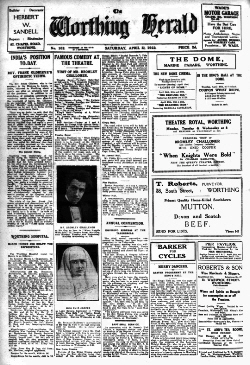 |
|||||||||||
|
[The front page of The Worthing Herald of 22nd April, 1922, featuring a review of The Lights of Home at the Dome Cinema (still in business) as well as an article about Bromley Challenor’s visit to the town with When Knights Were Bold.] _____
THE ENGLISH ROSE (1920)
The Bioscope (19 February, 1920 - p.29) Fred Paul is hard at work on the first of a series of productions which will be known as the Fred Paul British Standard Film productions. The subject selected is that fine drama by George R. Sims and Robert Buchanan, “The English Rose,” which ran for nearly a year at the Adelphi Theatre, and has since been played all over the world. Miss Amy Brandon Thomas will play the leading part, and Mr. Paul himself will play Father Michael. The cast also includes Sydney Folker, Humberstone Wright, Jack Raymond, George Turner, and May Morton. ___
The Bioscope (11 March, 1920 - p.126) As I foretold in my notes a fortnight ago, Fred Paul is now hard at work down at Ealing in the screen version of George R. Sims’s “The English Rose.” And more than that. He has been associated in the formation of a new British producing concern—British Standard Film Productions—whose managing director is Mr. John Robyns. Work on this production is now proceeding at Barker’s, and plans for extending that part of the premises already acquired are on the tapis. ___
The Bioscope (18 March, 1920 - p.90) Fred Paul has just finished screening “The English Rose,” the old Adelphi drama by George R. Sims and Robert Buchanan. In the cast are Amy Brandon-Thomas (daughter of the author of Charley’s Aunt), May Morton, Sidney Folker, Humbertson Wright, Jack Raymond, Clifford Desborough, and George Turner. Fred Paul himself enacts the rôle of “Father Michael.” His next production will be “Uncle Dick’s Darling” by H. J. Bryon. |
|||||||||||
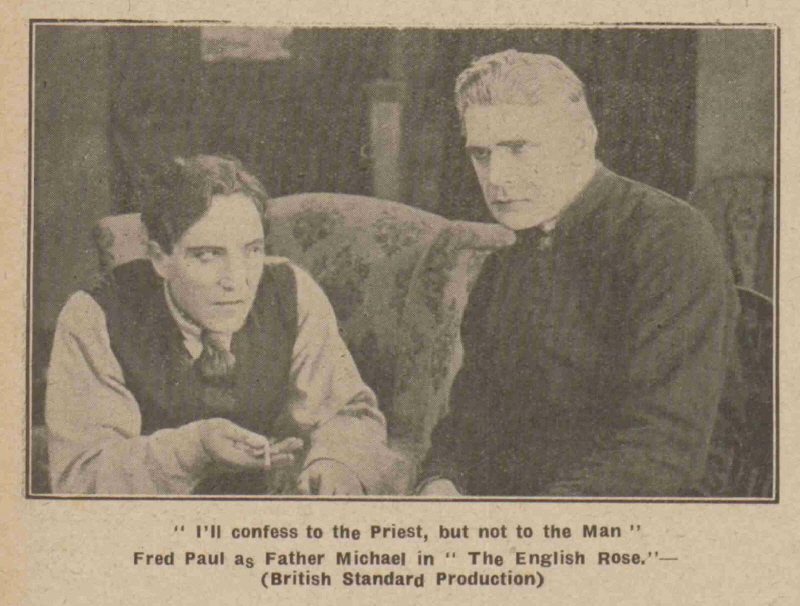 |
|
The Bioscope (1 July, 1920 - p.160) BRITISH STUDIOS . . . British Standard Film Productions, Ltd. Directors: JOHN ROBYNS (Managing Director). Formed about six months ago, with John Robyns as managing director, and Fred Paul, director of productions. Their first production was “The English Rose” adapted from the famous Adelphi drama by George R. Sims and Robert Buchanan. The cast included Amy Brandon-Thomas (daughter of the author of “Charley’s Aunt”), Sidney Folker, Humberston Wright, Jack Raymond, George Turner, May Morton, Clifford Desborough, and Fred Paul, who reappeared in an acting capacity for the first time since “The Dop Doctor.” He also directed the picture, and is now engaged on “Uncle Dick’s Darling,” by H. J. Byron. This features Athalie Davis, a screen actress of seventeen, who, at five and a half years of age, was painted by Alan Williams, the miniaturist, as the prettiest child in England. Supporting her are Frank Dane, Humberston Wright, Violet Bebbington, George Bellamy, Ronald Power, and Sidney Folker. The interior scenes are being taken at Barker’s Studios, Ealing Green. ___
The Bioscope (13 December, 1923 - p.40) “THE ENGLISH ROSE” Presented by: Astoria. THE STORY. Harry O’Malley is obliged to sell his ancestral home, which is bought by Sir Philip Kingston, a self-made man, with a beautiful daughter, Rose, with whom Harry falls in love. Captain MacDonnell, Sir Philip’s secretary, hopes to marry Rose in order to cover up his own defalcations. Sir Philip discovers his true character and dismisses him. MacDonnell shoots Sir Philip, and contrives to implicate Harry, who is arrested and found guilty by the Coroner’s Jury. MacDonnell’s accomplice makes a confession, which clears Harry. MacDonnell is arrested, and the young lovers are united. Harry O’Malley: SIDNEY FOLKER. Originally produced at the Adelphi Theatre over thirty years ago, this melodrama by George R. Sims and Robert Buchanan is a good sample of the fare popular at that theatre in the days when melodrama was at its best. It must be admitted that the piece shows signs of age, or perhaps requires something of the spirit of the late William Terriss to give it life and animation. The camera has a trick of showing up crudities of plot and construction, and the story seems a little thin and threadbare. But though the hero’s adventures are somewhat of the conventional order, and he is arrested for murder at the order of the villain, and apparently condemned to death and pardoned by a couple of village policemen, as played by Sidney Folker, he is certain to enlist the sympathies of a not too exacting audience, who will also be keenly interested in the heroine, charmingly played by Amy Brandon Thomas, and in the Father Michael of Fred Paul, the producer. ___
Dover Express (15 August, 1924 - p.6) |
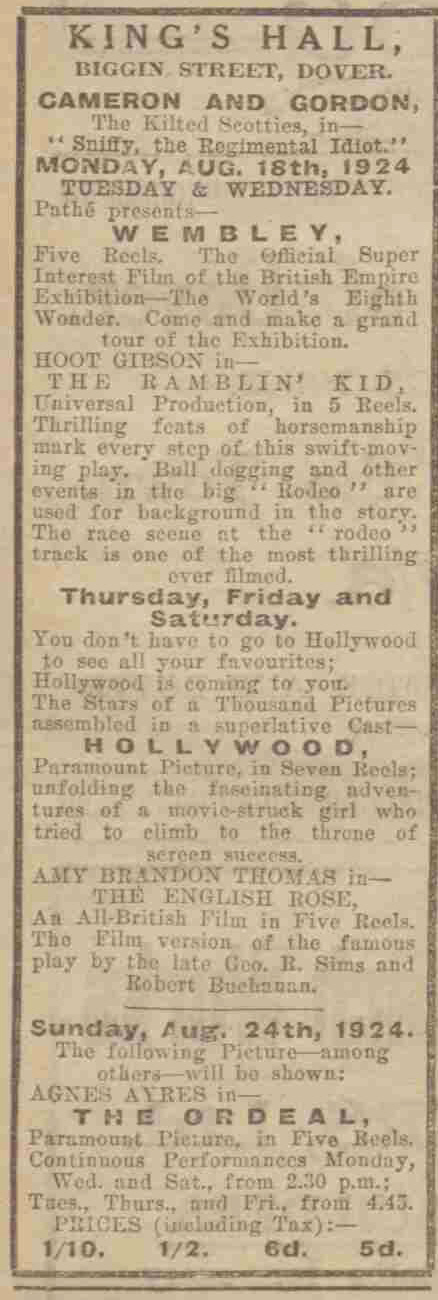 |
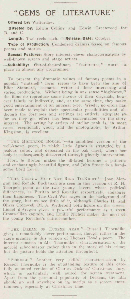 |
|
The Bioscope (20 September, 1923 - p.81) SELLING the PICTURE to the PUBLIC . . . “Gems of Literature” Walturdaw. Released Oct. 1, 1923 Invest these interesting two-reelers with special interest by having an elocutionist declaim parts of the poem when the film is made from poetry, or give a clearly-worded synopsis of the book or play from your stage prior to the screening of the film. Try to arrange also for your orchestra to play music of the period of the films. There is something of a boom in Old English songs and characteristic melodies just now in the musical world, probably started by “The Beggar’s Opera,” and cinemas have a fine chance of taking their share of popular interest. ___
The Hull Daily Mail (12 February, 1924 - p.2) |
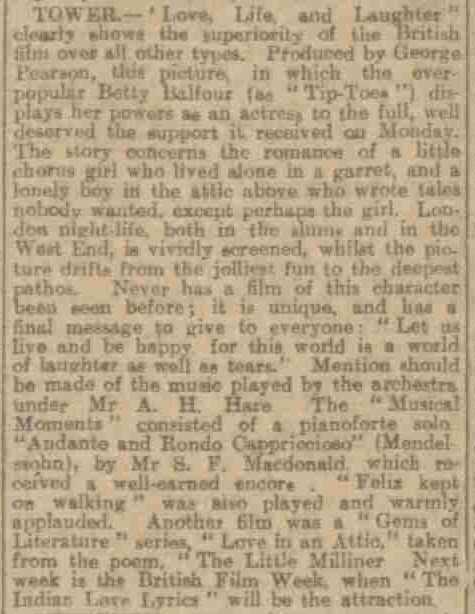 |
|
_____
A Robert Buchanan Filmography - continued
|
|
|
|
|
|
|